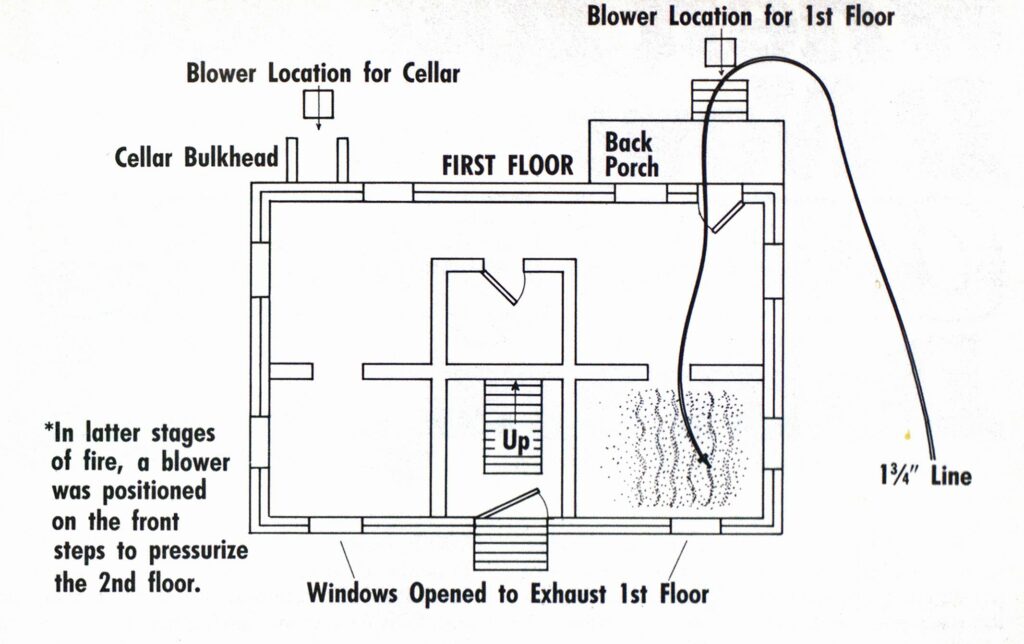
POSITIVE-PRESSURE VENTILATION ON THE FIREGROUND
STRATEGY & TACTICS
FOR SOME TIME, many of our discussions at the Mallets Bay, Vermont Volunteer Fire Department had centered around positive-pressure ventilation. We had all read articles expounding its benefits on the fireground but we had not had the opportunity to see it for ourselves. Our assistant chief brought in a video training tape on the subject and we arranged for a practical drill, using the fire station as a structure. We rigged streamers around all the possible horizontal openings to the station and supplied positive pressure using a pair of blowers mounted in piggyback. Firefighters used different combinations of horizontal ventilation, opening and closing various windows and doors throughout the drill session. We were impressed with the effectiveness of the procedure and the ease with which it could be accomplished.
A temporary PPV procedure was instituted to be used in various tactical situations that would probably be encountered in our fire response district. Little did we know that within the month we would be able to put the theoretical knowledge to good use on the fireground at a cellar fire in a twostory, balloon-frame structure used as a multiple dwelling.
At 7:30 on Easter morning of this year, our dispatcher received a phone alarm for a fire in a residence. In questioning the caller, the dispatcher accounted for all the occupants as being out of the structure, and alerted the fire department. A full structural assignment of two engines, one ladder truck, a rescue apparatus, and a staff/command vehicle was sent to the scene.
Things went right from the start. Two police officers on the scene were former firefighters and communicated needed information. The structure was heavily charged with smoke but no fire was visible on either the first or second floor; the occupants were all accounted for; and the hydrant was within 100 feet of the structure. The officers then stood by to assist in the hookup procedure.
As the first unit arrived, smoke was observed pushing forcibly from the basement windows and out of the clapboard seams at the level of the sill plate. The first crew donned SCBAs and advanced a 1 ¾-inch attack line to the firstfloor apartment. Assistant Chief Gary Francis also arrived and took command. He ordered the placement of the aerial to the driveway in preparation for venting at the roof level if necessary. The remaining crew members were to perform necessary forcible entry and assist in controlled horizontal ventilation. He also assured his water supply by ordering a 3-inch supply line from the nearby hydrant.
The interior crew reported heavy smoke but no fire. A high heat condition was felt at the floor area of the front corner of the occupancy. Realizing the strong possibility of a cellar fire, Chief Francis ordered the line to protect the interior cellar stairway and that a second 1 3/4-inch attack line be stretched to the rear cellar entrance to attack the fire from there—at ground level. The engine crew assigned that position reported a severe smoke condition and that the cellar was a virtual maze of partitions and doors. Visibility was zero and the heat condition was building.
By this time, I arrived and took command. I ordered that the two positivepressure fans be set up at the rear of the structure and pressurize the first floor and the cellar. Our PPV training sessions had continued regularly for the past four weeks and were fresh in the firefighters’ minds when they positioned the fans for operation.
As the fans were put in service the ladder crew vented the windows at the front of the structure, both on the first floor and the cellar. The effects of the PPV were almost instantaneous. The firefighters operating in the basement reported that visibility was increasing rapidly and that they could now find their way through the doors and halls to the seat of the fire. After a short application of water from the attack line the main body of the fire darkened down, and with very little water damage.
Chief of Department John Quinn arrived, took command, and ordered the relief of the interior crews. With the fire knocked down and the secondary search complete and negative, all that remained was the tedious job of overhauling and salvage. The minimum fire extension to the first floor was discovered and extinguished as the walls were opened and the insulation removed.


APPLYING WHAT YOU LEARN
The operation was successful, the building saved, damage was held to an amazing minimum, and there were no injuries. Why? Because we were able to apply what we had just learned: the positive effects of positive-pressure ventilation, reinforced at drills.
It’s often easy for firefighters to lose sight of actual application of standard operating procedures and new equipment that they learn about in training drills and lectures. This is particularly true in departments with infrequent responses and where structural responses are rare but routine in nature. This criteria is justification for repetitive drills in training. Hear it, say it, demonstrate it, and practice it often enough so that it will be second nature when the real thing comes along.

